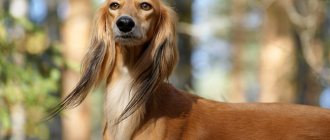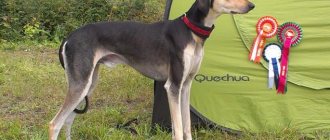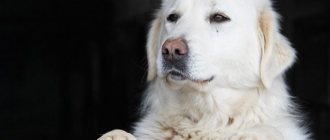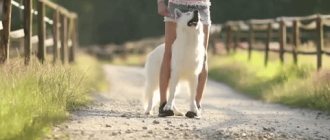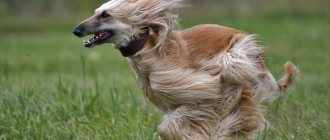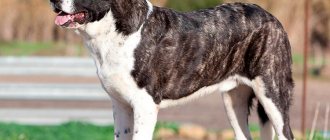Proud, noble, graceful, intelligent and sensitive - not every dog breed can boast such an enviable list of characteristics. The Saluki (Persian greyhound) is fully endowed with similar traits. There were times when in Eastern countries these dogs were more expensive than a thoroughbred horse.
Breed characteristics
| Short description | |
| Origin: | Middle East (country not specified) |
| Conditions of detention: | Country housing |
| Purpose: | Hunting |
| Color: | Anyone except brindle |
| Wool length: | Medium length, with fringes |
| Adult dog size: | The height of males is from 58 to 68 cm at the withers, females are slightly lower. Weight parameters have not been set. |
| Average life expectancy: | 12-15 years |
| Walk: | 2 times a day |
| Physical activity needs: | High level |
| Fédération Cynologique Internationale (FIC) classification: | Group No. 10 Greyhounds Section No. 1 Long-haired greyhounds or greyhounds with fringes |
| Puppy price: | On average: 25,000-70,000 rubles.
|
Vaccinations
Vaccination is carried out against the following diseases: canine distemper or distemper; parvovirus enteritis - the causative agent is parvovirus; infectious hepatitis - causative agent hepadnavirus; parainfluenza; rabies; leptospirosis; coronavirus; trichophytosis. When should a puppy have his first vaccination? At 2 months the first vaccination is carried out. After the injection, the puppy should not be washed, overfed or taken outside. Immunity after the first vaccine is developed within 12 days; this period becomes the most dangerous for the baby. A person needs to make a lot of effort to alleviate the puppy’s condition. After the first vaccination, puppies experience increased body temperature, general weakness and diarrhea. After 3 weeks, the puppy is given a second vaccination, but with the same vaccine. As a rule, after the second vaccination the dog feels much better, but for 12 days it must be protected from other animals, from drafts and not taken out for walks.
After this time, walks are allowed. At 6 months of age, the puppy is vaccinated against rabies and a complex vaccine against several diseases. It is forbidden to vaccinate if the dog's teeth are changing. You need to wait until all the teeth are replaced, and then vaccinate the baby. At one year of age, the dog is given a comprehensive vaccine. Further, once a year the dog should be vaccinated with the same complex vaccine. How to vaccinate a puppy? Only a qualified specialist should vaccinate a puppy. Before vaccination, he must examine the dog, measure its body temperature, and only if everything is normal, give the injection. The vaccine is placed either in the scruff of the neck or in the hip of the dog. The entire list of vaccinations administered by the veterinarian must be recorded in the dog’s passport. It also indicates the date of vaccination; subsequently, the owner himself will know the expected date of the next vaccination.
History of the origin of the species
The first mention of dogs of this type dates back to 3500 BC . The exact country of origin is not known for certain. It is noted that the homeland of these animals is the Middle East. Presumably the name of the breed comes from the city of Saluk, located in this territory. Dogs accompanied the nomadic Bedouins. The appearance of the animals changed depending on the habitat.
Dogs of similar appearance were also found in Egypt and Mesopotamia, depicted on frescoes and in tombs. The country's ruling elite used animals for entertainment - hunting birds, gazelles, rabbits and antelopes. At the same time, the dogs were delivered to the event site on horseback, along with their owners.
The qualities that underlay the selection were speed of movement and visual acuity. Dogs reach speeds of up to 70 km/h and are able to pursue a spotted target for a long time. It is unknown what breeds were used to create the Saluki, but research has revealed that they share genes with the wolf.
Animals of this species were considered very valuable; they were not sold, but could be given as gifts. Presumably this is how they got to China. It is known that the painting from 1427 depicts the emperor of the country along with a dog of a similar type. The first dogs were brought to Europe by participants in the Crusades. This fact is confirmed by medieval paintings depicting an unusual animal.
Large flows of Saluki into Europe began after the British conquest of the Arabian Peninsula in the 19th century. At the end of the century, F. Amherst brought several individuals to Great Britain and created a nursery. She is also the author of the first breed standard, developed in 1907.
After the discovery of Tutankhamun's tomb and the subsequent fashion for everything Egyptian, the Saluki gained popularity in Europe and was registered by the English Kennel Club. Interest in the country, and at the same time in the breed, subsided by 1930. The Second World War also significantly reduced the number of dogs.
At the moment, Salukis are popular in the Middle East and all Muslim countries. There, dogs are considered a “gift from Allah”, and the only “pure” animals among dogs . In other countries, representatives of the breed are present, but they are not the most fashionable.
Additional Information
Royal dog of Egypt. The Egyptian nobility considered the breed a valuable and honorable companion, and dogs were known to be mummified in the manner of Egyptian pharaohs. The remains of Persian greyhounds have been found in tombs on the upper Nile.
Self-sufficient dog. Salukis are part of the greyhound group. When hunting, greyhounds rely only on their eyesight. They track prey with their eyes and catch it at lightning speed. People can't keep up with these fast dogs, so the dogs work alone. Because of this feature, the Saluki's character is extremely independent.
Deceptive vulnerability. Salukis look very fragile, graceful and weak. Few people know that these dogs are capable of reaching speeds of about 50-70 km per hour, and some individuals can run at a speed of 90 km per hour. The Saluki is considered one of the fastest dogs in long distance racing. In addition, the Persian Greyhound is famous for its endurance and ability to work in almost any climatic conditions.
Webbed feet. Salukis have special membranes between their toes that allow them to run freely on sticky sand.
Luxury lovers. Due to their fragile constitution and fine coat, Persian greyhounds prefer to lie on sofas, beds and loungers.
Subtle soul. Sensitive Salukis do not tolerate family discord well. Conflicts and quarrels can negatively affect the character of a susceptible dog.
Smoothies. Among the breed there are individuals without long decorative hair on the ears and tail. Such dogs are called “smooths,” which means “smooth” in English.
Distinctive features
Arabian Greyhounds must meet the parameters set by the FCI standard. Basic requirements of the regulatory document:
- The head is narrowed, of pronounced length, has a noble and graceful appearance . The forehead is not convex, the stop is almost invisible.
- bite . The jaws are strong, the teeth are complete.
- The lobe is black or brown.
- The eyes are oval-shaped, large, but do not give the impression of being bulging. The color of the iris varies from walnut tone to dark and rich. The look is meek, but emphasizing one’s own dignity.
- The neck is muscular, elongated, graceful.
- The ears are of pronounced length and are distinguished by a high set. At rest they are adjacent to the muzzle, in other cases they are mobile.
- The tail is low set, reaching to the hock joint or below. Slightly curved, creates a natural impression. Usually does not rise above the line of the spine.
- The torso is square in shape, but due to the thin physique and strongly toned abdomen, a feeling of elongation is created. The sternum is stretched in length, not flat. The ribs are clearly visible. The wide back goes into a slightly arched lower back.
- Legs are straight, powerful, with developed thighs and shins. The pasterns are flexible, have a slight slope, the shoulder blades are set back, the same length as the shoulders. The paws are medium-sized, flexible, with elongated toes, between which there is thick hair.
- The movements are light, without raising the forelimbs, and turn into a trot.
- The coat is presented in 2 variants : completely smooth and type with feathering. In any case, the hair is soft and shiny. Feathering in adult Salukis is present on the limbs, back of the thigh, and throat. Long hair covers the ears and the lower part of the tail.
Description
Standard number: FCI No269
Group: greyhounds for hunting and racing.
Section: greyhounds with long hair or feathering.
The overall appearance of the Saluki is the embodiment of proportionality, grace and elegance. There are many varieties, but there are common standards for all representatives of the breed.
- Head. The skull has a highly elongated shape and is comparable in width to the body. The transition from the forehead to the muzzle is weakly expressed. The space between the ears is even, without bulges. The ears are mobile and set high, and when at rest they fit snugly to the head. There is long soft hair on the ears. The dog must have an even bite. The nose can be black or brown. The eyes are large, but not protruding.
- The neck is long, graceful, with well-developed muscles.
- The back is quite wide. Deep, large chest, toned stomach. The front of the body is much larger than the back.
- The tail should not be higher than the hock joint. It is set low and quite long. On the lower part there is a characteristic dewlap made of soft wool.
- The forelimbs are well laid back and have well-developed muscles. The shoulders and shoulder blades are approximately equal in length. Long, straight forearms flow into wide, powerful pasterns. On the hind limbs the hock joints are well defined and the articulations of the knee joints are almost not pronounced.
- The wool is smooth and soft. There are featherings on the legs, tail and throat. Rough or felted wool is considered a serious fault.
Main characteristics of an adult dog:
- weight – 14 – 27 kg;
- height – 60 – 70 cm;
- life expectancy is 10-14 years.
Any color is allowed, but brindle is considered undesirable. But at the same time, brindle color is not a defect and cannot be the reason for the disqualification of a pet in competitions, for example.
Photo of an adult dog
Photos of puppies
Features of character and behavior
Saluki with its entire appearance shows nobility of origin and self-esteem. Has a bright breed character.
Advantages
- Dogs of this species have an even and calm character. They do not provoke fights, get along with other dogs, but are not timid or shy.
- Salukis are attached to their owner, but do not try to bother him with their company.
- They are affectionate with the owner and family, love their company, but prefer the position of simply being nearby.
- Dogs calmly react to the appearance of strangers and rarely bark at them.
- They also coexist comfortably with children (except for the smallest ones).
- Representatives of the breed will not show aggression, even if the child handles them carelessly; they will rather simply leave.
Flaws
- Despite its devotion to its owner, the dog does not obey unquestioningly. During the pursuit, she may well ignore his commands. The same situation will arise if the dog is tired of training, is tired or is not interested.
- Due to its strong hunting instinct, the animal should only be walked on a leash.
- When prey of any kind is detected, the dog will begin to hunt, and given its speed of movement and ability to jump high, it will be difficult to catch up with the Saluki.
- Also, the dog will not tolerate the presence of small pets on its territory.
- Salukis do not accept rudeness, shouting, or swearing, even if they are not directed at her. The animal will be nervous and worried.
- You can also note the touchiness and vulnerability of such a pet, his love of freedom and stubbornness.
- The low sociability inherent in the breed does not allow them to become everyone’s favorite, because in relations with strangers they remain neutral.
Attitude towards others
The Saluki cannot be called a sociable dog; thanks to the aloofness instilled by the first owners, the dog acquired independence and indifference to the environment. The pet does not show aggression towards strangers, but will not experience warm feelings. Salukis behave normally in the company of other dogs, but do not suffer when there is no one to communicate with.
Reference! It is difficult to teach a born hunter not to chase cats or catch rodents, since the dog considers such animals to be game.
Care and maintenance
Saluki wool is easy to care for. However, its length and density make it necessary to use overalls in winter.
Their physique and lack of fat require a soft and warm bed. Otherwise, the dog will sleep on the owner's bed.
Closed ears require the owner's attention. It is necessary to frequently inspect the inside and clean it on time. This way you can avoid inflammation and also not miss the appearance of a tick. The eyes are examined weekly and, if necessary, washed with water or chamomile infusion.
The claws usually grind down on their own, because... This is an active dog, but it is advisable to monitor their condition monthly and trim them if necessary. Teeth need to be cleaned 1-2 times every 7 days. Overall, this is a healthy dog with no genetic problems.
Nutrition
Representatives of the breed have a thin build and rarely gain excess weight. Their activity allows them to burn a lot of calories, which maintains their natural shape. However, due to high energy costs, it is worth feeding a pet of this breed more often than others.
Usually, for adult dogs over 10 months , feeding twice a day is sufficient; it is better to offer Salukis 3 meals . The frequency of feeding puppies is slightly different. Two-month-old babies are fed 5 times a day , after 2 months it is reduced to 4, and by six months to 3 .
Salukis are not prone to allergies, so they can be fed natural food. Preference should be given to lean meats, offal, vegetables, unsweetened fruits, and dairy products. Among porridges, it is better to choose rice or buckwheat. Twice a week you should include eggs and sea fish in your diet.
It is forbidden to feed too salty, fried, pickled or spicy, as well as give bones and chocolate.
It is acceptable to use professional dry or wet food as the basis of nutrition. They have a balanced diet and sufficient amounts of vitamins. It is advisable to choose food of the premium or super-premium level and the “for active breeds” category.
We recommend that you read a detailed article on the topic: “How and what to feed a dog: types and characteristics of nutrition.”
Health
This breed is not artificially bred; a long period of natural selection has created a genetically healthy dog.
Vaccinations
Vaccinating your pet allows you to develop immunity to common dangerous diseases. 7 days before each procedure, it is necessary to give the animal an anti-helminth remedy. Babies are vaccinated twice, at 8 and 12 weeks , and adult dogs once a year .
Diseases that vaccination will protect against:
- plague;
- hepatitis;
- parovirus enteritis;
- rabies;
- coronavirus;
- parainfluenza;
- leptospirosis;
- trichophytosis.
After the vaccine is administered, the puppies are quarantined, because... immune defense has not yet developed. At this time, the owner must monitor the health of the pet; if the temperature rises, vomiting or other health problems, it is necessary to show the baby to the veterinarian. During the quarantine period, it is prohibited to walk your pet outside.
Important article on the topic: “Everything you need to know about dog vaccinations.”
Diseases
Salukis have almost no health problems, especially of a genetic nature. Possible diseases include:
- Cardiomyopathy . A pathology that disrupts the normal contractility of the myocardium, as well as reducing the pumping function of the organ.
- Hypothyroidism . Suggests decreased production of thyroid hormones.
- Hemangiosarcoma . A malignant tumor that occurs inside blood vessels.
Other medical complications include an increased reaction to anesthetic compounds. In this regard, it is necessary to give them a lesser dose of anesthesia than representatives of other breeds.
Walk
Saluki is a very active breed . They will not be able to stay at home without harming their health. They need to run and jump, so it is better to walk your pet in a park where there is enough space, or keep it in a country house with a large yard. Representatives of the breed will be interested in overcoming obstacles and accompanying the owner while rollerblading or cycling. Dogs pay almost no attention to toys, balls and frisbees.
When walking, it is worth taking into account the animal’s hunting instincts; after seeing the target, the dog may stop reacting to the owner. Therefore, it is better to keep your pet on a long leash, or let it go only in a fenced area . The fence should be high; a small Saluki can overcome it without any problems. At the request of the owner, you can involve the dog in training for hunting tasks, or engage them in coursing.
Grooming
- The coat of representatives of the breed is not very long, except for the area of the ears, tail and feathers, so it does not cause any special problems in care.
- It needs to be combed weekly, and during shedding or after going outdoors, additionally treat it with a comb.
- If dirty, wipe the pet's paws and fur with a damp cloth. It is not recommended to bathe your dog too often, so as not to spoil the condition of the coat.
If washing cannot be avoided, it is better to do it without using shampoo and soap. Full treatment is advisable no more than once a year.
Saluki diseases
No severe hereditary genetic pathologies have been found in Persian greyhounds. Dogs are distinguished by excellent health and good immunity . But in very rare cases they get sick:
- Hypothyroidism. An endocrine disease associated with insufficient production of thyroid hormones. Symptoms will be: hair loss, sudden weight gain, lethargic and apathetic behavior, severe fatigue, drooling, etc. The quality of life decreases. Hormone therapy helps.
- Cardiomyopathy. A disease of the cardiovascular system, expressed in shortness of breath, drowsiness, dry cough, lethargy, weight loss, and seizures. It is fraught with unexpected death . Complete recovery is impossible; symptoms can be mitigated by taking medications.
Like all greyhounds, Salukis do not tolerate anesthesia or any anesthesia well.
Mating
Dogs that have documents of origin (pedigree), as well as the necessary exhibition achievements, are allowed to breed. In this case, it can be guaranteed that the puppies will have an exterior characteristic of the breed, as well as sufficient health. Both parents must reach 2 years of age , be vaccinated according to age and treated for helminths.
It is better to introduce a couple selected at the club on neutral territory. After this, you need to wait until the pets calm down and begin to show interest in each other. Next, you should move to the male’s territory, where mating will take place. The meeting is repeated 1-2 more times at intervals of 24 hours.
Read a detailed article on the topic: “Everything you need to know about breeding dogs: appropriate age, what to do if it doesn’t work out, rules and tips.”
Catering
Strong recommendations, akin to demands on the part of breeders, lie in the area of feeding gazelle dogs. Here, the opinions of foreign and domestic breeders agree that for Salukis, a diet of ready-made super-premium food for dogs leading an active lifestyle is preferable. Even puppies at one month of age begin to be accustomed to dry food soaked in bitch milk or water.
Important! The main thing is that the dog’s diet contains clean water in sufficient quantities. Clean and high-quality water is an integral part of a balanced diet for the Saluki.
Key points in training
The proud, stubborn and uncommunicative nature of the Saluki makes it difficult to train.
- Despite his devotion to his owner, the dog will not ingratiate himself and try to attract his attention by complete submission.
- He may ignore commands if he is uninterested, tired, or simply doesn't want to.
- You cannot force or swear at a Saluki, the dog will be offended.
The best strategy is to teach through play or treats, with a short period of practicing one task, resting, and moving on to a new command. It is better to start raising and training Salukis from a very early age in order to reinforce basic behavioral skills. If the owner has little experience, it is better to seek the help of a professional.
Read about how to properly train a dog in the article: “Training a puppy: effective methods from dog handlers, learning commands at home.”
Theses
- They love to run and need daily activity.
- But you need to walk them on a leash, unless you are convinced that the area is safe. The Saluki has a strong instinct that makes it chase animals.
- They love family, but do not trust strangers. Early socialization is important to eliminate fearfulness and timidity.
- It is necessary to provide a comfortable bed, since the dog does not have enough fat.
- For older children they can be friends and comrades, but for little ones they are not recommended.
- Rarely voice.
- When training a Saluki, you need to be consistent, persistent and use only positive methods.
- They should not be kept in a home with small pets. Sooner or later the end will come.
- They can be picky eaters.
How to choose a puppy
A healthy Saluki baby can only be purchased from trusted breeders or a nursery. Animals purchased without documents cannot be guaranteed to match the breed or have no diseases. When visiting a breeder, you should check the pedigrees of the parents, their veterinary passports, and the puppy's birth certificate.
It would be useful to observe the parents of the future pet, in this way you can assess its potential appearance as an adult, as well as see the main behavioral traits. It should be noted that the puppy does not have fringes, even if the parents have them. The baby will only have downy hair in these areas.
When getting to know a young Saluki, you need to evaluate his reaction to the approach of strangers, noise, and also watch him play with his brothers and sisters. The puppy should not show timidity, cowardice, or aggression. The dog may be interested, but not excited.
The Saluki is an excellent pet for those who appreciate natural breeds with a distinctive character. The owner is required to respect the dog, patience, proper level of workload and education. If these conditions are met, the owner will receive a loyal, balanced animal, whose appearance has not changed much since the times of Ancient Egypt.
5 / 5 ( 1 voice )
Price
Today, you can buy a Saluki puppy from individual breeders and nurseries. Experienced dog breeders recommend the second option. The fact is that in nurseries, before purchasing a dog, they provide documentary guarantees regarding its health and condition.
Important! Be sure to pay attention to whether the puppy has all the necessary vaccinations. Information about them should be in his personal passport.
The price of a Saluki breed , or rather a 2-month-old puppy from a nursery, is 30-55 thousand rubles. Purchasing an animal without a pedigree and relevant documents from private breeders will cost 25-30 thousand rubles. However, there are also more expensive offers, starting from 60 thousand rubles.
Regardless of where exactly you decide to purchase a puppy, in a nursery or from a breeder, pay attention to such parameters as its appearance and curiosity.
